(完整版)Unit2bodylanguage知识点归纳
- 格式:docx
- 大小:9.95 KB
- 文档页数:2

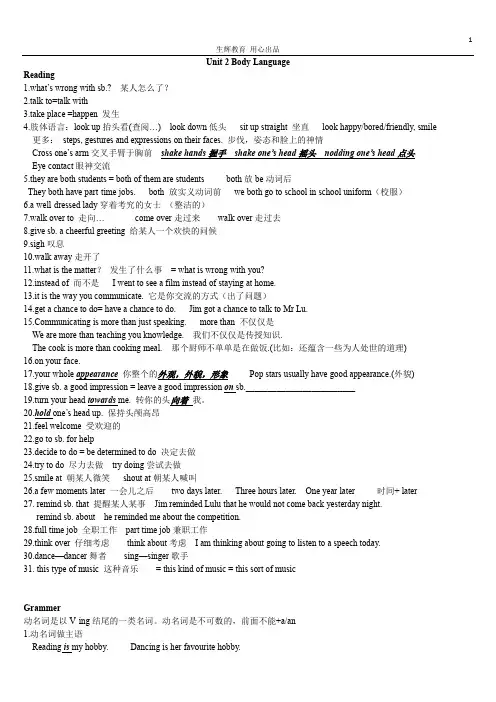
Unit 2 Body LanguageReading1.what’s wrong with sb.? 某人怎么了?2.talk to=talk with3.take place =happen 发生4.肢体语言:look up抬头看(查阅…) look down低头sit up straight 坐直look happy/bored/friendly, smile 更多:steps, gestures and expressions on their faces. 步伐,姿态和脸上的神情Cross one’s arm交叉手臂于胸前shake hands握手shake one’s head摇头nodding one’s head点头Eye contact眼神交流5.they are both students = both of them are students both放be动词后They both have part-time jobs. both 放实义动词前we both go to school in school uniform(校服)6.a well-dressed lady穿着考究的女士(整洁的)7.walk over to 走向…come over走过来walk over走过去8.give sb. a cheerful greeting 给某人一个欢快的问候9.sigh叹息10.walk away走开了11.what is the matter?发生了什么事= what is wrong with you?12.instead of 而不是I went to see a film instead of staying at home.13.it is the way you communicate. 它是你交流的方式(出了问题)14.get a chance to do= have a chance to do. Jim got a chance to talk to Mr Lu.municating is more than just speaking. more than 不仅仅是We are more than teaching you knowledge. 我们不仅仅是传授知识.The cook is more than cooking meal. 那个厨师不单单是在做饭.(比如:还蕴含一些为人处世的道理)16.on your face.17.your whole appearance你整个的外观,外貌,形象Pop stars usually have good appearance.(外貌)18.give sb. a good impression = leave a good impression on sb._________________________19.turn your head towards me. 转你的头向着我。
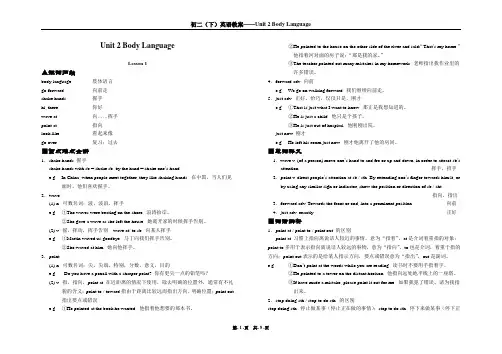
Unit 2 Body LanguageLesson 1▲短词归纳body language 肢体语言go forward 向前走shake hands 握手hi, there 你好wave at 向……挥手point at 指向look like 看起来像go over 复习;过去■重点难点全讲1.shake hands 握手shake hands with sb.= shake sb. by the hand = shake one’s hande.g. In China, when people meet together, they like shaking hands. 在中国,当人们见面时,他们喜欢握手。
2.wave(1) n. 可数名词:波,波浪,挥手e.g. ①The waves were beating on the shore. 浪涛拍岸。
②She gave a wave as she left the house. 她离开家的时候挥手告别。
(2) v. 摇,挥动,挥手告别wave at/ to sb. 向某人挥手e.g. ①Martin waved us goodbye. 马丁向我们挥手告别。
②She waved at him. 她向他挥手。
3.point(1) n. 可数名词:尖,尖端,特别,分数,意义,目的e.g. Do you have a pencil with a sharper point? 你有更尖一点的铅笔吗?(2) v. 指,指向,point at 在近距离的情况下使用,除去明确的位置外,通常有不礼貌的含义;point to / toward指由于距离比较远而指出方向,明确位置;point out指出要点或错误e.g. ①He pointed at the book he wanted. 他指着他想要的那本书。
②He pointed to the house on the other side of the river and said:“That’s my home.”他指着河对面的房子说:“那是我的家。
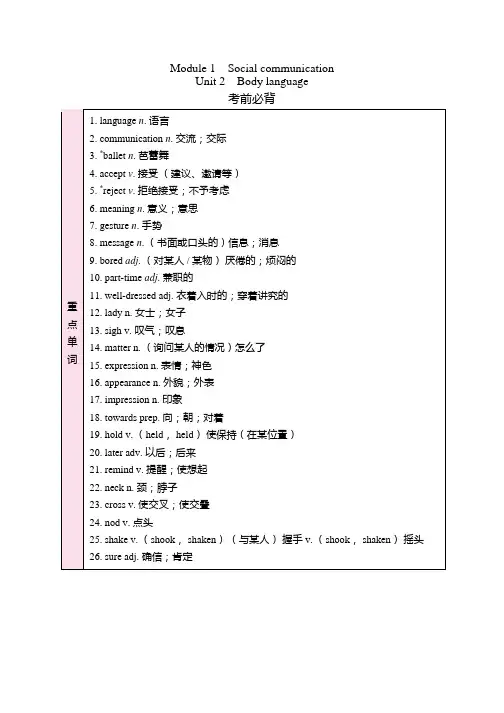
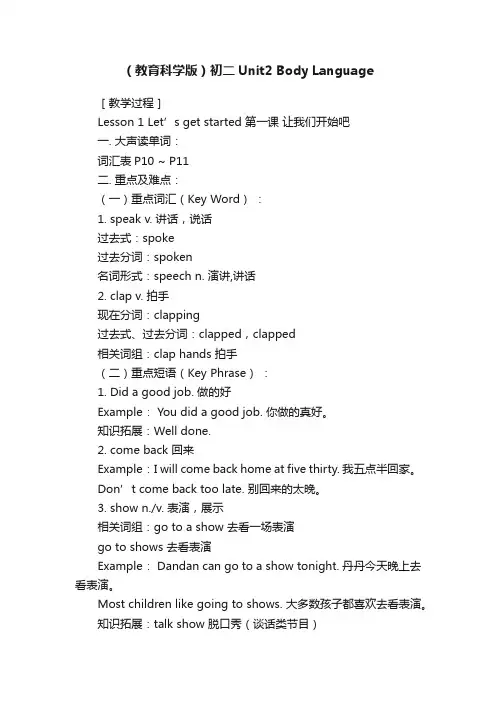
(教育科学版)初二Unit2 Body Language[教学过程]Lesson 1 Let’s get started 第一课让我们开始吧一. 大声读单词:词汇表P10 ~ P11二. 重点及难点:(一)重点词汇(Key Word):1. speak v. 讲话,说话过去式:spoke过去分词:spoken名词形式:speech n. 演讲,讲话2. clap v. 拍手现在分词:clapping过去式、过去分词:clapped,clapped相关词组:clap hands 拍手(二)重点短语(Key Phrase):1. Did a good job. 做的好Example: You did a good job. 你做的真好。
知识拓展:Well done.2. come back 回来Example:I will come back home at five thirty. 我五点半回家。
Don’t come back too late. 别回来的太晚。
3. show n./v. 表演,展示相关词组:go to a show 去看一场表演go to shows 去看表演Example: Dandan can go to a show tonight. 丹丹今天晚上去看表演。
Most children like going to shows. 大多数孩子都喜欢去看表演。
知识拓展:talk show 脱口秀(谈话类节目)fashion show 服装表演mime show 哑剧表演,默剧表演4. by + 点钟到…点by 8 o’clock : not later than 8 o’clockExample:You should come back home by 10 o’clock. 你应该在十点之前回家。
5. in the library 在图书馆Example:I want to read in the library. 我想在图书馆里读书。
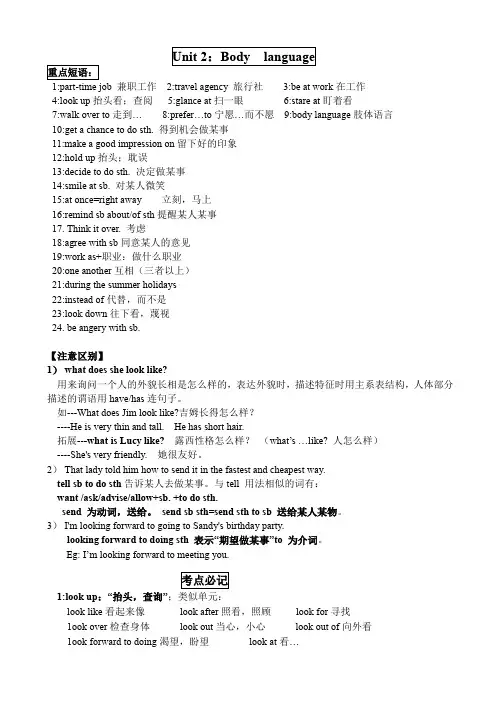
1:part-time job 兼职工作2:travel agency 旅行社3:be at work在工作4:look up抬头看;查阅5:glance at扫一眼6:stare at盯着看7:walk over to走到… 8:prefer…to宁愿…而不愿9:body language肢体语言10:get a chance to do sth. 得到机会做某事11:make a good impression on留下好的印象12:hold up抬头;耽误13:decide to do sth. 决定做某事14:smile at sb. 对某人微笑15:at once=right away 立刻,马上16:remind sb about/of sth提醒某人某事17. Think it over. 考虑18:agree with sb同意某人的意见19:work as+职业:做什么职业20:one another互相(三者以上)21:during the summer holidays22:instead of代替,而不是23:look down往下看,蔑视24. be angery with sb.【注意区别】1)what does she look like?用来询问一个人的外貌长相是怎么样的,表达外貌时,描述特征时用主系表结构,人体部分描述的谓语用have/has连句子。
如---What does Jim look like?吉姆长得怎么样?----He is very thin and tall. He has short hair.拓展---what is Lucy like? 露西性格怎么样?(what’s …like? 人怎么样)----She's very friendly. 她很友好。
2)That lady told him how to send it in the fastest and cheapest way.tell sb to do sth告诉某人去做某事。

Unit 2 Body Language单词1. language n.语言Many deaf people use sign language.许多失聪着都使用手势语。
2. communication n.交流;交际Language is the most important tool in communication.语言是最重要的交际工具。
communicate v. 交流;交际一般和with连用we have never communicated since we graduated.毕业后我们就再也没有联系过。
3. ballet n.芭蕾舞She is keen on ballet. 她热衷于芭蕾舞。
ballet 单指“芭蕾舞”这种舞蹈类型时,是不可数名词;但表示《天鹅湖》之类的具体的芭蕾舞剧时,是可数名词。
4. accept v.接受(建议、邀请等) &receive作比较accept 表示“接受(建议、邀请等)”时,可作及物动词或不及物动词。
如:she offered him a lift and he accepted it.他请他搭她的便车,他领情了。
He asked her to marry him and she accepted.他向她求婚,她同意了。
acceptance n.接受;接纳5. reject v. 拒绝接受;不予考虑 rejection n.拒绝;摈弃The chief editor rejected his suggestion.主编拒绝了他的建议。
6. meaning n.意义;意思I cannot understand the meanings of these symbols.我无法理解这些符号的含义。
mean v.意思是… meaningful adj.有意义的7. gesture n.手势 gesture v. 用手势表示The children were amused at his funny gestures.他滑稽的手势把孩子们都逗乐了。
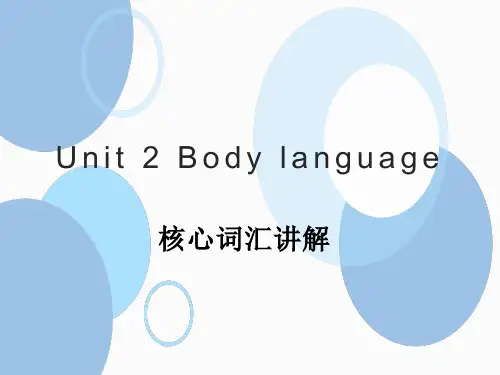
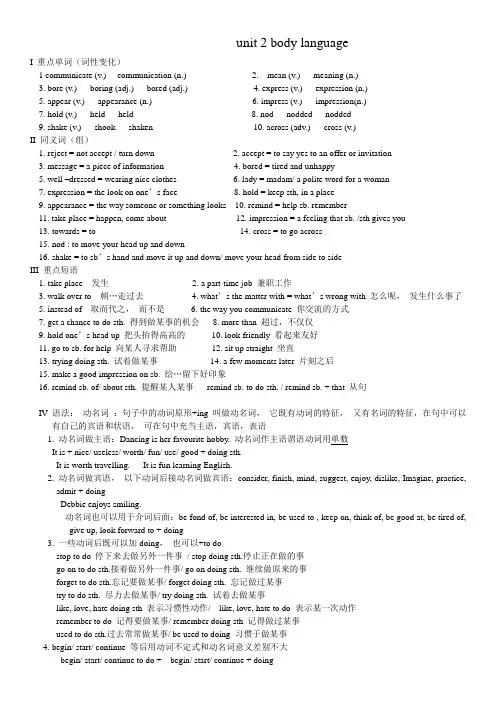
unit 2 body languageI 重点单词(词性变化)1 communicate (v.)--- communication (n.) 2. mean (v.) --- meaning (n.)3. bore (v.) --- boring (adj.) --- bored (adj.)4. express (v.) --- expression (n.)5. appear (v.) --- appearance (n.)6. impress (v.) --- impression(n.)7. hold (v.) --- held --- held 8. nod --- nodded --- nodded9. shake (v.) --- shook --- shaken 10. across (adv.) --- cross (v.)II 同义词(组)1. reject = not accept / turn down2. accept = to say yes to an offer or invitation3. message = a piece of information4. bored = tired and unhappy5. well –dressed = wearing nice clothes6. lady = madam/ a polite word for a woman7. expression = the look on one’s face 8. hold = keep sth, in a place9. appearance = the way someone or something looks 10. remind = help sb. remember11. take place = happen, come about 12. impression = a feeling that sb. /sth gives you13. towards = to 14. cross = to go across15. nod : to move your head up and down16. shake = to sb’s hand and move it up and down/ move your head from side to sideIII 重点短语1. take place 发生2. a part-time job 兼职工作3. walk over to 朝…走过去4. what’s the matter with = what’s wrong with 怎么呢,发生什么事了5. instead of 取而代之,而不是6. the way you communicate 你交流的方式7. get a chance to do sth. 得到做某事的机会8. more than 超过,不仅仅9. hold one’s head up 把头抬得高高的10. look friendly 看起来友好11. go to sb. for help 向某人寻求帮助12. sit up straight 坐直13. trying doing sth. 试着做某事14. a few moments later 片刻之后15. make a good impression on sb. 给…留下好印象16. remind sb. of/ about sth. 提醒某人某事remind sb. to do sth. / remind sb. + that 从句IV 语法:动名词:句子中的动词原形+ing 叫做动名词,它既有动词的特征,又有名词的特征,在句中可以有自己的宾语和状语,可在句中充当主语,宾语,表语1. 动名词做主语:Dancing is her favourite hobby. 动名词作主语谓语动词用单数It is + nice/ useless/ worth/ fun/ use/ good + doing sth.It is worth travelling. It is fun learning English.2. 动名词做宾语,以下动词后接动名词做宾语:consider, finish, mind, suggest, enjoy, dislike, Imagine, practice,admit + doingDebbie enjoys smiling.动名词也可以用于介词后面:be fond of, be interested in, be used to , keep on, think of, be good at, be tired of, give up, look forward to + doing3. 一些动词后既可以加doing,也可以+to dostop to do 停下来去做另外一件事/ stop doing sth.停止正在做的事go on to do sth.接着做另外一件事/ go on doing sth. 继续做原来的事forget to do sth.忘记要做某事/ forget doing sth. 忘记做过某事try to do sth. 尽力去做某事/ try doing sth. 试着去做某事like, love, hate doing sth 表示习惯性动作/ like, love, hate to do 表示某一次动作remember to do 记得要做某事/ remember doing sth 记得做过某事used to do sth.过去常常做某事/ be used to doing 习惯于做某事4. begin/ start/ continue 等后用动词不定式和动名词意义差别不大begin/ start/ continue to do + begin/ start/ continue + doing5. 一些感官动词see/ watch / notice / hear/ find + doing sth …正在做…see/ watch / notice / hear/ find + do sth …做某事的全国产或经常做I heard him singing in the classroom.I often hear him sing on the Sunday morning.六.书面表达:一) 便条:今天是4 月7 日,星期四。

Unit 2 Body LanguageLesson 1▲短词归纳body language 肢体语言go forward 向前走shake hands 握手hi, there 你好wave at 向……挥手point at 指向look like 看起来像go over 复习;过去■重点难点全讲1.shake hands 握手shake hands with sb.= shake sb. by the hand = shake one’s hande.g. In China, when people meet together, they like shaking hands. 在中国,当人们见面时,他们喜欢握手。
2.wave(1) n. 可数名词:波,波浪,挥手e.g. ①The waves were beating on the shore. 浪涛拍岸。
②She gave a wave as she left the house. 她离开家的时候挥手告别。
(2) v. 摇,挥动,挥手告别wave at/ to sb. 向某人挥手e.g. ①Martin waved us goodbye. 马丁向我们挥手告别。
②She waved at him. 她向他挥手。
3.point(1) n. 可数名词:尖,尖端,特别,分数,意义,目的e.g. Do you have a pencil with a sharper point? 你有更尖一点的铅笔吗?(2) v. 指,指向,point at 在近距离的情况下使用,除去明确的位置外,通常有不礼貌的含义;point to / toward指由于距离比较远而指出方向,明确位置;point out指出要点或错误e.g. ①He pointed at the book he wanted. 他指着他想要的那本书。
②He pointed to the house on the other side of the river and said:“That’s my home.”他指着河对面的房子说:“那是我的家。
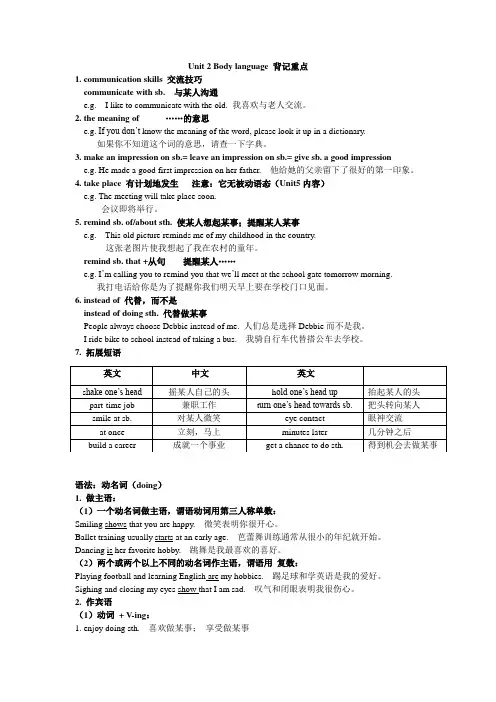
Unit 2 Body language 背记重点1. communication skills 交流技巧communicate with sb. 与某人沟通e.g. I like to communicate with the old. 我喜欢与老人交流。
2. the meaning of ……的意思e.g. If you don’t know the meaning of the word, please look it up in a dictionary.如果你不知道这个词的意思,请查一下字典。
3. make an impression on sb.= leave an impression on sb.= give sb. a good impressione.g. He made a good first impression on her father. 他给她的父亲留下了很好的第一印象。
4. take place 有计划地发生注意:它无被动语态(Unit5内容)e.g. The meeting will take place soon.会议即将举行。
5. remind sb. of/about sth. 使某人想起某事;提醒某人某事e.g. This old picture reminds me of my childhood in the country.这张老图片使我想起了我在农村的童年。
remind sb. that +从句提醒某人……e.g. I’m calling you to remind you that we’ll meet at the school gate tomorrow morning.我打电话给你是为了提醒你我们明天早上要在学校门口见面。
6. instead of 代替,而不是instead of doing sth. 代替做某事People always choose Debbie instead of me. 人们总是选择Debbie而不是我。
Unit2 body language 语法复习温故知新:动词不定式动词不定式做主语动词不定式的基本形式为“to+动词原形”,其否定形式是“not to + 动词原形”。
它能起名词的作用,在句子中充当主语、表语、宾语和宾语补足语。
动词不定式在作主语时,用法主要有以下两种:1.动词不定式作主语时常用it作形式主语,而往往将动词不定式放在谓语或表语之后。
如:It’s not easy to learn a foreign language well. (=To learn a foreign language well is not easy.)在此句型中,如果要说明动词不定式的动作是谁做的,可在不定式前加一个for引起的短语,作不定式的逻辑主语。
如:It’s difficult for us to finish the work. 对我们来说,完成这项工作很困难。
It’s hard for me to answer your question. 要我回答你的问题很难。
但是,如果表语是kind,nice,right,wrong,clever,polite等描述行为者的性格、品质的形容词,则应在不定式前加一个of引起的短语。
如:这个例子属于上面的换一个of引起的。
It’s very kind of you to help me. 你能帮我,真好。
1)of sb.和for sb.这两种结构还有一个区别,在of sb.结构中,可用sb.直接作句子的主语来改写成“It’s + 形容词+ of sb. + 动词不定式”结构。
试比较:It’s foolish of him to go alone. (=He was foolish to go alone.)他单独出去太傻了。
It’s k ind of you to give me the book. (=You are kind to give me the book.)你给我这本书,真是太好了。
八年级讲义一必记单词Language communication meaning hold later remind cross shake sure message gesture bored expression matter appearance impression二常考短语Body language take place sit up remind sb about sth make a good impression on三重要知识点1 To one’s surprise 让某人吃惊的是in surprise 惊讶地be surprised to do 对于做某事感到很惊讶To our surprise, he arrived at the station in time.The girl heard from her mother in surprise.I am surprised to find great changes have taken place in China.2 take place 发生没有被动语态Take place 指事先安排好的,有计划的发生,没有“偶然”的意味Happen 指偶然发生Happen to sb 某人发生Happen to do sth 碰巧做某事It happens that +从句碰巧......What happened to you?I happened to see my friend in the shop.It happened that I had no money yesterday.=I happened to have no money yesterday.Great changes have taken place in China since 1978.When did the accident happen?Eg: The Olympic Games of 2016 will __________in Brazil.A take afterB take offC take placeD take away3 on show 在展出for show 为了炫耀show sb around 带领某人参观show off 炫耀show up 显露4 look down 俯视look up 仰视look down upon 轻视,看不起=look down onPerson 是个体名词,泛指man,woman,child中任何一个人,可以说a person.People 是集合名词,表示复数概念。
Unit 2 Body Language 一、教学内容:Unit 2 Body Language二、教学目标知识目标:熟练掌握本单元课文中的单词,短语和句型。
能力目标:培养学生的综合运用知识的能力。
三、教学难点:培养学生的综合能力四、重点知识:单词:本单元所有单词(单词表中)短语:1) tone of voice 说话的语气2) facial expression 面部表情3) disagree with…不同意某人的观点4) be angry with sb. 生某人的气5) tend to do sth. 倾向于做某事6) by reading the body 通过观察肢体语言7) even though 即使8) all the time 一直,始终9) nod one’s head 点头10) stay close to each other 彼此靠近11) shake hands with sb. 与某人握手12) back and forth 来回地13) cross one’s legs 跷二郎腿14) in order to do sth. 为了做某事15) avoid doing sth. 避免做某事16)in public 在公共场所17) more than half of 多数……18) care less about 不在意19) kiss on both cheeks 吻在双颊上20) preten d to do sth. 假装做某事五、重点知识讲解:1. Do you know body language? Do you know that more than half of our ideas or f eelings are expressed by our tone of voice, our facial expressions, our gestures and the way we position our body when we speak? We can read the mind by understanding these non-verbal messages.译文:你了解肢体语言吗?你知道我们的多数想法或感情都是由我们说话时的语气、面部表情、手势和身体的姿势所表达的吗?我们可以通过这些非言语的信息来理解人的心思。
高一英语下册必修二Body language知识点解析高一英语下册必修二Bodylanguage知识点解析适当做一些练习,尤其是针对自己不足之处的练习是必不可少的。
一起来看看高一频道为大家准备的《高一英语下册必修二Bodylanguage知识点解析》吧,希望对你的学习有所帮助!重要词汇1.statement;n.陈述;说明state-vt.陈述;叙述;声明2.greet-v问候,迎接,打招呼greetingn敬礼,致意greetings问候语,致词3.represent-v.代表,象征representative-n.代表4..association;n.社团;联系;联想associate;vt.使发生联系,使联合adj.associated联合的,关联的5.curiousadj.好奇的curiouslyadv.好奇地6.dormitoryn宿舍7.approach;vi.vt.接近;靠近n.接近;方法;途径.approachable-adj.可到达的;可亲近的8.defend-vt.保护;保卫defense-n.防卫;防卫设备;防御9.major--adj.主要的minor--adj.较小的;次要的10.dash-v猛冲,突进.11.misunderstand-vt.误解;误会misunderstanding-n.误解;误会understanding--n.谅解,理解12.adult-n成人,成年人adj成人的,成熟的13.spoken-adj.口语的unspoken-adj.非口语的;未说出口的14.function-n作用,动能,只能v-起作用,运转15.likely--adj.可能的16.falseadj错误的,假的true真的,正确的17.ease--n.安逸;舒适vt.减轻(痛苦;忧虑)easeful--adj.舒适的,安逸的18.truly--adv.真实地;真诚地;真正地true--adj.真实的,真正的19.anger-n.怒气;怒火angry--adj.生气的重点短语1.defendagainst保卫以免受2.intruducesbtosb向某人介绍某人3.kisssbonsomepart亲吻某人的某个部位4.indefence防御,保障5.togetherColombia,closelyfolloithfromBritain.第一个到达的是从哥伦比亚来的托尼加西亚,随后紧跟着的是英国的茱莉亚史密斯。
Un it 2 Body Ian guage 背记重点
1. com munication skills 交流技巧
com mun icate with sb. 与某人沟通
e.g. I like to com muni cate with the old. 我喜欢与老人交流。
2. the meaning of ..... 的意思
e.g. If you don kho t the meaning of the word, please look it up in a dict ion ary. 如果你不知道这个词的意
思,请查一下字典。
3. make an impressi on on sb.= leave an impressi on on sb.= give sb. a good impressi on
e.g. He made a good first impressio n on her father. 他给她的父亲留下了很好的第一印象。
4. take place有计划地发生注意:它无被动语态(Unit5内容)
e.g. The meeting will take place soon.
会议即将举行。
5. remi nd sb. of/about sth. 使某人想起某事;提醒某人某事
e.g. This old picture reminds me of my childhood in the coun try.
这张老图片使我想起了我在农村的童年。
remi nd sb. that + 从句提醒某人....
e.g. I'm call ing you to remi nd you that we 'meet at the school gate tomorrow morni ng. 我打电话给你是为
了提醒你我们明天早上要在学校门口见面。
6. instead of代替,而不是
in stead of doi ng sth. 代替做某事
People always choose Debbie in stead of me. 人们总是选择Debbie 而不是我。
I ride bike to school in stead of taki ng a bus. 我骑自行车代替搭公车去学校。
7. 拓展短语
语法:动名词(doing )
1. 做主语:
(1)一个动名词做主语,谓语动词用第三人称单数:
Smili ng shows that you are happy. 微笑表明你很开心。
Ballet trai ning usually starts at an early age. 芭蕾舞训练通常从很小的年纪就开始。
Dancing is her favorite hobby. 跳舞是我最喜欢的喜好。
(2)两个或两个以上不同的动名词作主语,谓语用复数:
Playi ng football and learni ng En glish are my hobbies. 踢足球和学英语是我的爱好。
Sighi ng and closi ng my eyes show that I am sad. 叹气和闭眼表明我很伤心。
2. 作宾语
(1)动词+ V-ing :
1. enjoy doi ng sth. 喜欢做某事;享受做某事
2. suggest doing sth. 喜欢做某事
3. mind doing sth. 介意做某事
4. finish doing sth. 完成做某事
5. practise doing sth. 介意做某事
6. imagine doing sth. 想象做某事
7. deny doing sth. 否认做某事
8. keep doing sth. 继续做某事
9. miss doing sth. 错过做某事
10. avoid doing sth. 避免做某事
11. admit doing sth. 承认做某事
(2)介词+ V-ing
12. prefer doing sth. to doing sth. 对比to 后的事情,更喜欢做前面的事情
13. be used to doing sth 习惯做某事
14. look forward to doing sth. 期望做某事
15. feel like doing sth.
16. give up doing sth.
17. keep on doing sth.
18. succeed in doing sth.
19. insist on doing sth.
3. 惯用法
20. be busy doing sth.
21. be worth doing sth. 想做某事
放弃做某事反复做某事;不断做某事成功地做某事坚持做某事
忙于做某事”
“值得做某事”
22.lt 'no use / good doi ng sth. 做…•无用/ 无好处”
4. 既能加to do 又能加doing 的动词
23. try doing sth. 试着做某事(新的尝试)try to do sth. 努力做某事(想达到目
的)
24. stop doing sth. 停止做某事
stop to do sth. 停下来做另一件事
25. remember doing sth. 记得做过某事remember to do sth. 记得要做某事
26. forget doing sth. 忘记做过某事forget to do sth. 忘记要做某事。